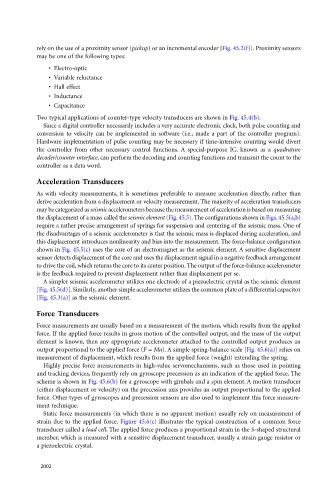Page 1169 - The Mechatronics Handbook
P. 1169
rely on the use of a proximity sensor (pickup) or an incremental encoder [Fig. 45.2(f)]. Proximity sensors
may be one of the following types:
• Electro-optic
• Variable reluctance
• Hall effect
• Inductance
• Capacitance
Two typical applications of counter-type velocity transducers are shown in Fig. 45.4(b).
Since a digital controller necessarily includes a very accurate electronic clock, both pulse counting and
conversion to velocity can be implemented in software (i.e., made a part of the controller program).
Hardware implementation of pulse counting may be necessary if time-intensive counting would divert
the controller from other necessary control functions. A special-purpose IC, known as a quadrature
decoder/counter interface, can perform the decoding and counting functions and transmit the count to the
controller as a data word.
Acceleration Transducers
As with velocity measurements, it is sometimes preferable to measure acceleration directly, rather than
derive acceleration from a displacement or velocity measurement. The majority of acceleration transducers
may be categorized as seismic accelerometers because the measurement of acceleration is based on measuring
the displacement of a mass called the seismic element (Fig. 45.5). The configurations shown in Figs. 45.5(a,b)
require a rather precise arrangement of springs for suspension and centering of the seismic mass. One of
the disadvantages of a seismic accelerometer is that the seismic mass is displaced during acceleration, and
this displacement introduces nonlinearity and bias into the measurement. The force-balance configuration
shown in Fig. 45.5(c) uses the core of an electromagnet as the seismic element. A sensitive displacement
sensor detects displacement of the core and uses the displacement signal in a negative feedback arrangement
to drive the coil, which returns the core to its center position. The output of the force-balance accelerometer
is the feedback required to prevent displacement rather than displacement per se.
A simpler seismic accelerometer utilizes one electrode of a piezoelectric crystal as the seismic element
[Fig. 45.5(d)]. Similarly, another simple accelerometer utilizes the common plate of a differential capacitor
[Fig. 45.3(a)] as the seismic element.
Force Transducers
Force measurements are usually based on a measurement of the motion, which results from the applied
force. If the applied force results in gross motion of the controlled output, and the mass of the output
element is known, then any appropriate accelerometer attached to the controlled output produces an
output proportional to the applied force (F = Ma). A simple spring-balance scale [Fig. 45.6(a)] relies on
measurement of displacement, which results from the applied force (weight) extending the spring.
Highly precise force measurements in high-value servomechanisms, such as those used in pointing
and tracking devices, frequently rely on gyroscope precession as an indication of the applied force. The
scheme is shown in Fig. 45.6(b) for a gyroscope with gimbals and a spin element. A motion transducer
(either displacement or velocity) on the precession axis provides an output proportional to the applied
force. Other types of gyroscopes and precession sensors are also used to implement this force measure-
ment technique.
Static force measurements (in which there is no apparent motion) usually rely on measurement of
strain due to the applied force. Figure 45.6(c) illustrates the typical construction of a common force
transducer called a load cell. The applied force produces a proportional strain in the S-shaped structural
member, which is measured with a sensitive displacement transducer, usually a strain gauge resistor or
a piezoelectric crystal.
©2002 CRC Press LLC

